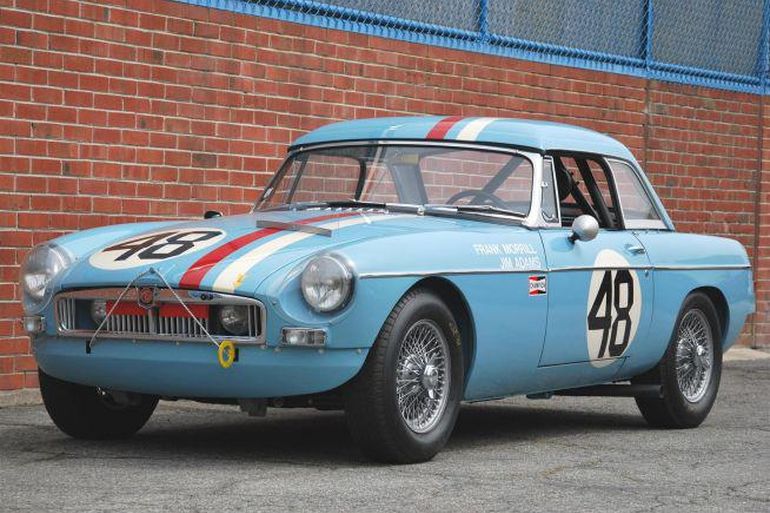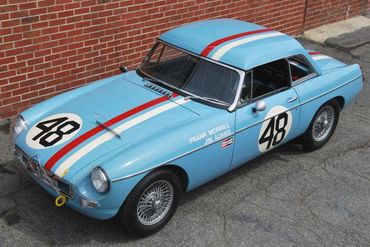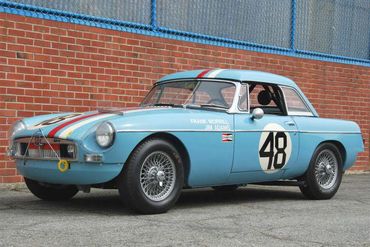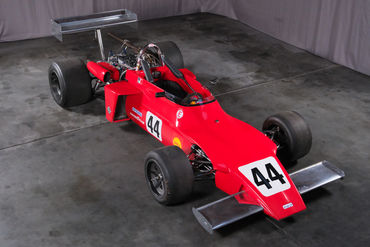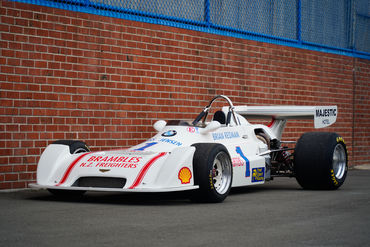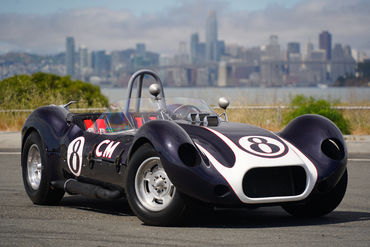Sold
SOLD 05/11
1962 MG
B Lightweight Sebring
Spectacularly Restored, Ex-BMCD Team Car, Sebring 1964, 1 of 4 Genuine Lightweight Cars Built
- VINGHN 3L/112
- Exterior ColorIsis Blue
- Interior ColorBlack with Light Blue Piping
- Mileage13243 Miles
- Engine1.8 Litre 4-Cylinder
- Transmission4-Speed
- StatusSold
- StockFJ1082
Description
1962 MGB Lightweight
s/n GHN 3L/112
Isis Blue with Black Leather Interior with Light Blue Piping.
In 1964, San Francisco’s British Motor Cars Distributors ran three very special lightweight MGBs at the 12 Hours of Sebring. The cars were specially prepared by Joe Huffaker who headed BMCD’s competition department, and is also well known in motorsports circles for his instrumental role in the effective and innovative Huffaker Genies, which were among the earliest mid-engined race cars built. The Sebring MGs were run by BMCD with factory backing, and were specially equipped with high performance engines and factory competition components including plastic windows and aluminum front fenders, hood, deck lid, and doors. Four examples in all were built of the lightweight MGBs.
Then, as now, Sebring was a high profile international road racing event, being part of the Challenge Mondiale and Prototypes Trophy, in the company of such legendary events as the Targa Florio, Le Mans, and the Nurburgring 1000km. MG’s factory effort at Sebring in March of 1963 proved to be disappointing, due in large part to the fact that the MGB had only just been introduced in late 1962, and the severe winter in England that year prevented much testing of the cars before shipping them to Florida for the race. BMCD’s Sebring effort had done much better in 1963, running a lightweight E-Type to an impressive 7th overall finish, so the MG factory turned their support to BMCD for 1964 to run three very early production 1962 MGBs, which were liveried in red (#47), white (#46), and blue (#48). In fact, this car was either the fifth or sixth MGB built. The motors were special Abingdon Competitions Department units, which were supplied to BMCD and then reworked under Huffaker’s supervision to provide even higher performance. This included revised porting, new pistons, and Huffaker’s own specification cam grind. During the race at Sebring, the white car retired following an off, but the red and blue cars finished the event, and the blue car finished 4th in class and 22nd overall.
After Sebring, the car was sold on to William Schmidt of Martinez, California, who used the car as a daily driver for a time because he had to trade his race and street MG’s in order to purchase the car. He raced the car regularly from 1964 to 1968, before selling it to Rob Smith, who owned it until 1974. Mac Townsend owned the car from 1974 to 1984, but never raced it, and sold it to Butch Gilbert. Mr. Gilbert also owned the red Sebring car (#47), and was delighted to find that the blue car was complete with all of its original Sebring equipment, including the BMC competition engine, with only 24 documented races on it. The car had survived wonderfully, with all of its original and unique equipment, such as the aluminum panels (still with paint and numbers from the Sebring race!), aluminum battery box cover, dual gas tanks, adjustable rear shocks, close ratio gear box, side running lights, Marchal headlamps and driving lights, perspex headlamp covers, and chronometric tachometer. The original engine had even survived with the car, complete with cast magnesium intake manifold, special generator, lightweight starter, and engine stabilizer.
He performed a comprehensive restoration to the highest standards between 2002 and 2004, and no aspect of the car was left untouched. The restoration was performed to the car’s Sebring 1964 specification, and was fastidiously performed with an eye for historical accuracy. Upon its completion, the car was featured on the cover of the July 2004 issue of Vintage Racecar. There is also a feature in the magazine on the car, and a copy is included with the car. The car also appeared at the HMSA Sebring reunion in March of 2004, and has been featured in a number of magazines including Sports Car International and Classic Motorsports. A new engine was just built for the car by Joe Huffaker, and the original unit from the 1964 Sebring race is included with the car as well.
The car has seen minimal use since the restoration, and remains very fresh. The paintwork was done to high standards and is excellent, with no significant deterioration. The front of the car has been protected with clear bra. The body is straight and the panels fit well, although there is a crack in the door skin near the quarter window. The chrome and trim are excellent throughout, and the car has a number of very neat details, from the Perspex headlamp covers and bug deflector, to the green running lamp and number ball light. The wheels are in excellent shape, as is all glazing, which is entirely plastic other than the front windscreen. The lights are in excellent condition throughout.
The interior is equally nice. The seats were done in black leather with light blue piping, with a purposeful bucket seat for the driver. The door panels were done in black, again with blue piping, a stylish and thoughtful detail. The dashboard is excellent, and has been signed by Kjell Qvale (Owner of BMCD) and Joe Huffaker. The instruments are excellent, and the car retains its rare chronometric tachometer. The floors are nicely finished, and there are MG rubber mats to protect the footwells. The roll bar is nicely done and the overall feel is of a high quality restoration done to high standards that preserves the vintage feel of the car.
The engine compartment and trunk are both spotless. The firewalls and inner fenders are beautifully painted to match the exterior, and the large capacity fuel tank with quick release filler is spotlessly clean as well. The engine is also extremely clean, having just been rebuilt and installed, while the wiring and ancillaries are extremely tidy throughout. There is a large capacity radiator with electric fan to keep the temperature in check.
This is an exceptional opportunity to acquire a one-of a kind MG that enjoys excellent provenance. Not only is it one of the very first MGBs built, but the car is also one of four Lightweights built using factory parts. The car has been carefully kept its entire life so that the rare parts have all survived with the car. It has never had to be reconstituted and its history is well-known, which of course includes the 1964 Sebring race. The car has been beautifully restored and has both a new Huffaker engine with no time on it, as well as the original engine with which the car ran Sebring. It is eligible for historic events worldwide and has FIA papers. It also comes with a number of spares including differential, ring and pinion, starter, gaskets, electrical and ignition components, brake components, filters, and many other bits and pieces, including the original motor.
The above vehicle information is complete and accurate to the best of our knowledge at the time it is posted to this website. Corrections or additional information is always appreciated. All advertised prices exclude government fees and taxes, any finance charges, any dealer document preparation charge, and any emission testing charge. Vehicles are subject to prior sale. All advertised to be true but not guaranteed. We assume no liability for errors or omissions.
Inquire About This Car
Fantasy Junction • 510-653-7555 • 1145 Park Ave, Emeryville, CA 94608
